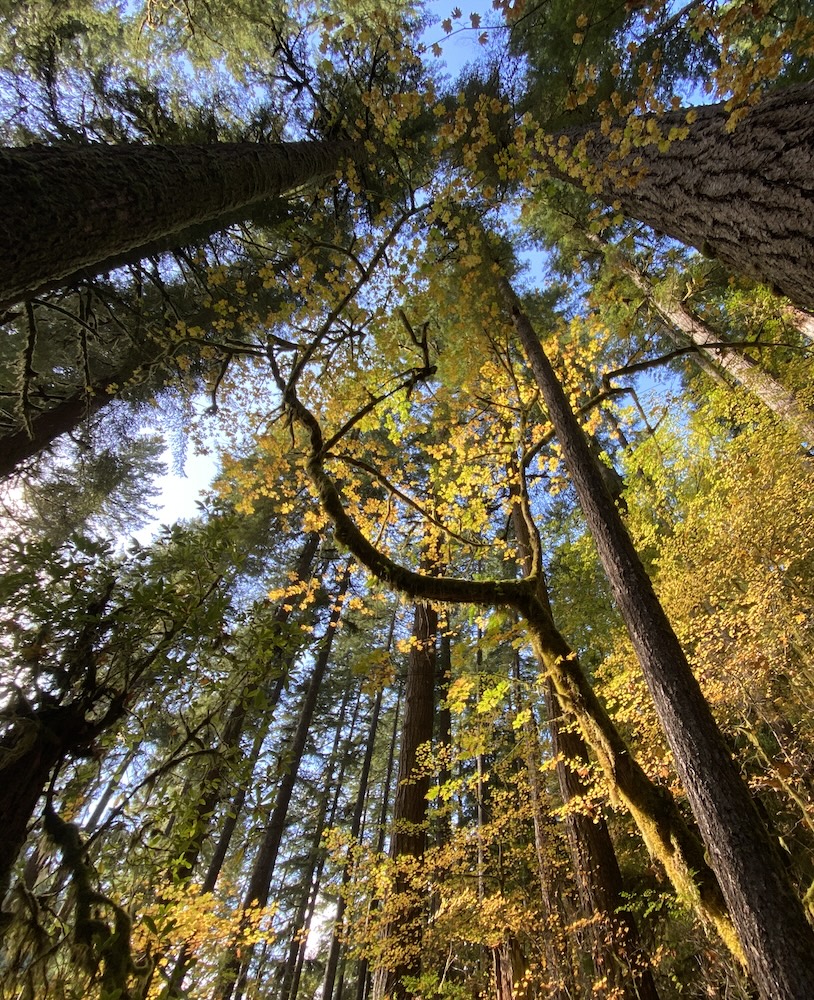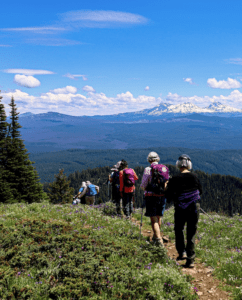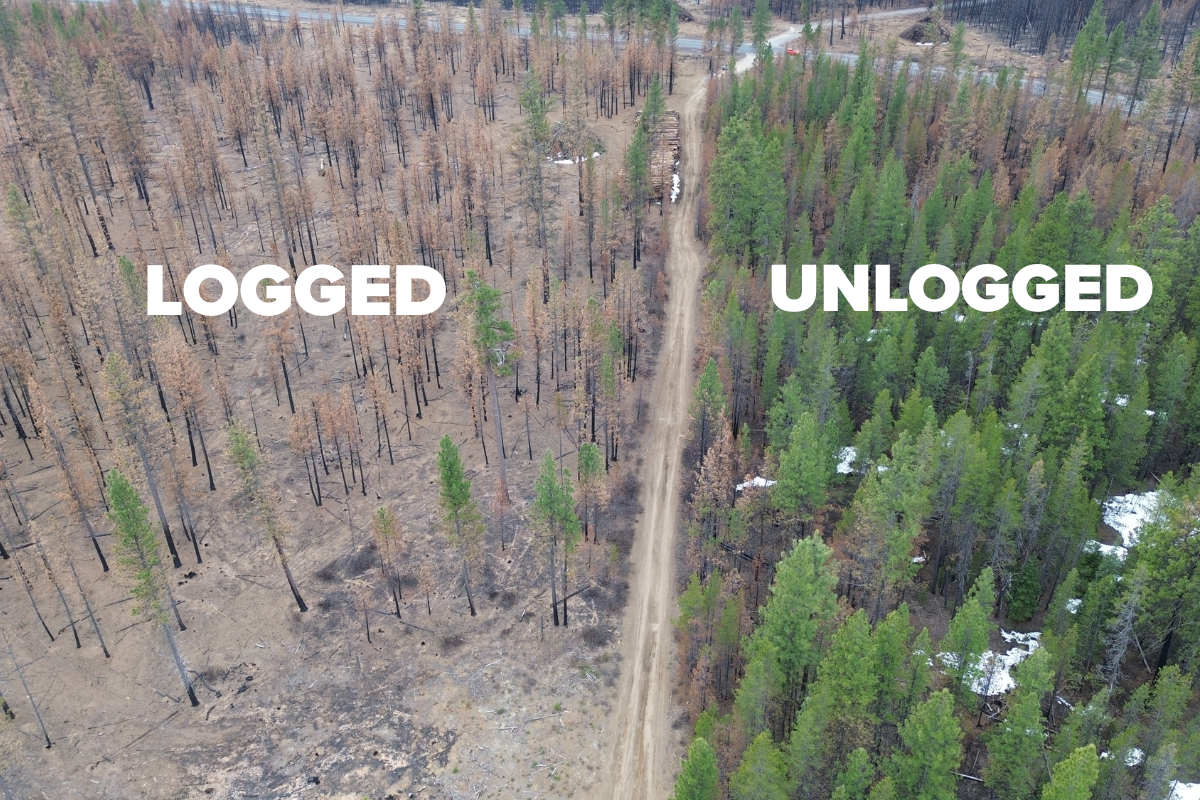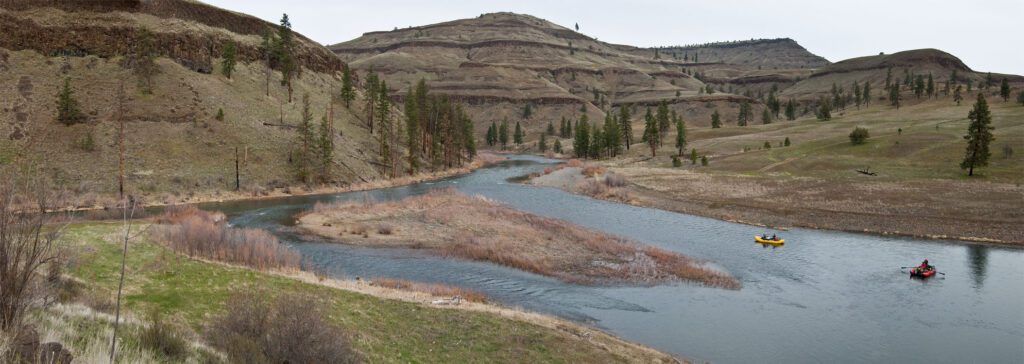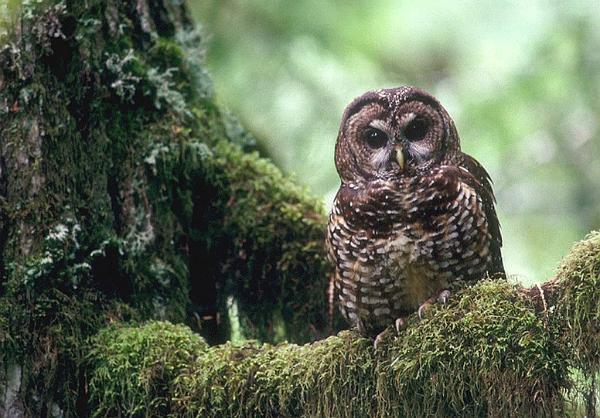They say a picture is worth a thousand words, and the photo below tells quite a story.
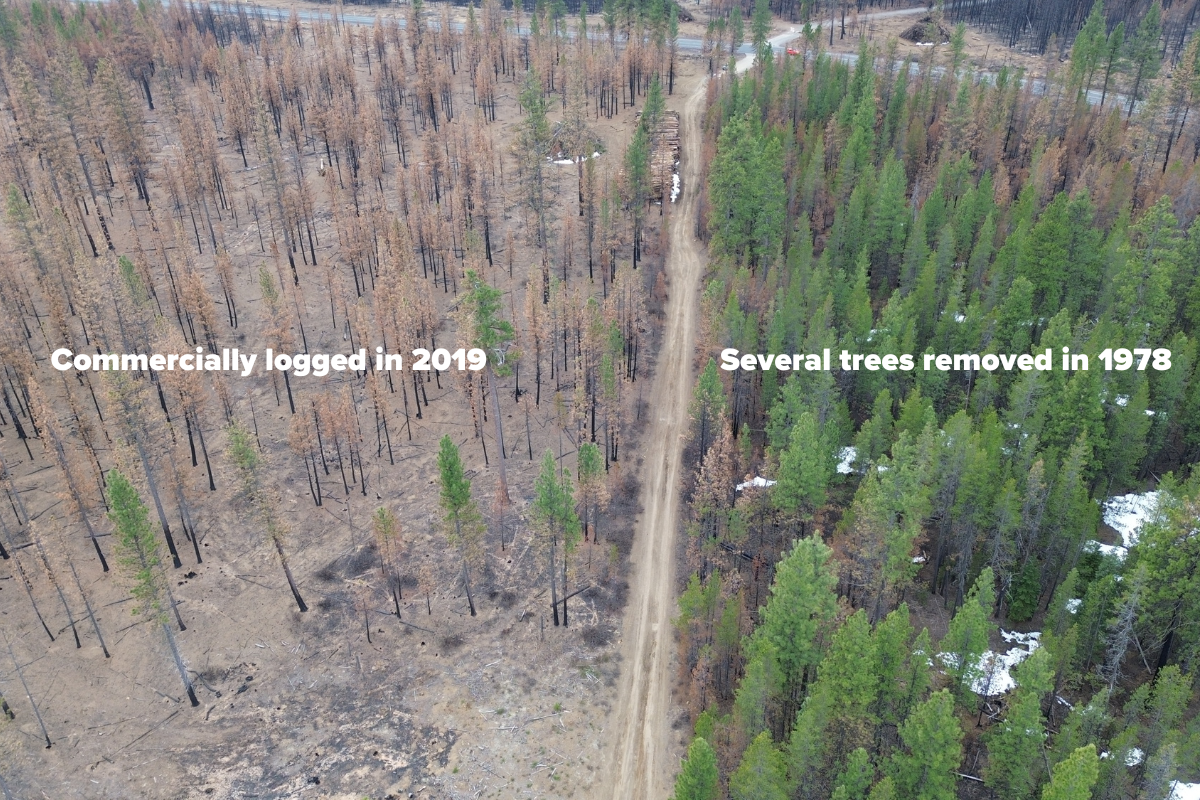
This aerial image shows two adjacent forest stands within the Little Lava Fire burn area, in the Deschutes National Forest, just SE of Mount Bachelor. Single-selection thinning was done in both stands in 1978. This is when just a few individual trees within the stand are removed. The stand on the left side of the road was then commercially logged in 2019, which, as you can see in the photos, significantly reduced stand density and opened up the forest canopy. The stand on the right was undisturbed over the last 40 years.
When the Little Lava Fire burned through here last fall, much of the forest that was logged in 2019 resulted in high tree mortality. On the other side, the fire only burned and killed a few trees on the perimeter of the stand, but most are still green and alive.
Aggressive logging often makes fire risk worse
All too often, aggressive logging projects remove the large, mature trees that are the most fire resilient and leave behind smaller, younger trees that are more flammable. These projects also open the forest canopy, allowing more sun to reach and dry out the forest floor. Add in hotter, drier summers caused by climate change, and all of this can add up to increased fire risk and more flammable forests.
On the other hand, mature and old-growth forests across Oregon have unique adaptations to survive–and thrive–in fire-prone landscapes. Fire is natural and necessary for the health of these forests and the wildlife that depend on them for habitat. Larger and older trees, especially species like Ponderosa pine that are prevalent across forests in Central Oregon, develop thick, fire-resistant bark and self-prune their lower branches as they age, making them more resistant and resilient to wildfire. These forests also have more canopy cover than logged forests, creating cooler and wetter conditions on the forest floor that can reduce the risk of intense fire. Take a look at the top photo again; in the unlogged stand on the right, you can still see patches of snow (this photo was taken in late-April 2025). On the left, the soil in the open stand dried out much faster due to increased sun and wind exposure.
Despite the timber industry’s claims that more “active management” and “fuels reduction” are needed to prevent catastrophic wildfires, the science shows that logging is not preventing large wildfires. In fact, logging can often make fire risk and severity much worse. One Oregon study found that corporate-owned tree plantations burned at 30% higher severity than adjacent older stands on public lands.
This has become a common talking point for the timber industry, who claim that forests are overgrown (and, thus, more susceptible to high-severity fire) due to a lack of management and that management (aka logging) is our best tool against climate-driven wildfires. This simple claim is driving much of the current national forest policy and an increase in poorly designed logging projects that are spreading like wildfire across the country.
Last fall’s Little Lava Fire, in the Deschutes National Forest, allowed us an opportunity to visit a recent burn area and see how forests that were commercially logged fared in the fire compared to adjacent forests that have not been logged as aggressively, and still maintain mature forest characteristics.
Touring the Little Lava Fire
Much like the other severe wildfires that have erupted across the west in recent years, this fire was driven by climate change–namely, high winds and drought-like conditions.
The fire started near Little Lava Lake, the headwaters of the Deschutes River, from lightning strikes in early September 2024. High winds and dry conditions allowed the fire to quickly spread east towards the town of Sunriver, burning through logged forest, unlogged forest, and even fields of lava rock that are common in the area.
Oregon Wild staff visited the burn area in April 2025 and sent up our trusty drone to take aerial photos of the burned forest. After referencing the photos with historical logging data, we found that previously logged forests still burned at high-severity and did not stop the fire. We also found that, in some cases, logged stands burned much hotter than adjacent, unlogged stands.
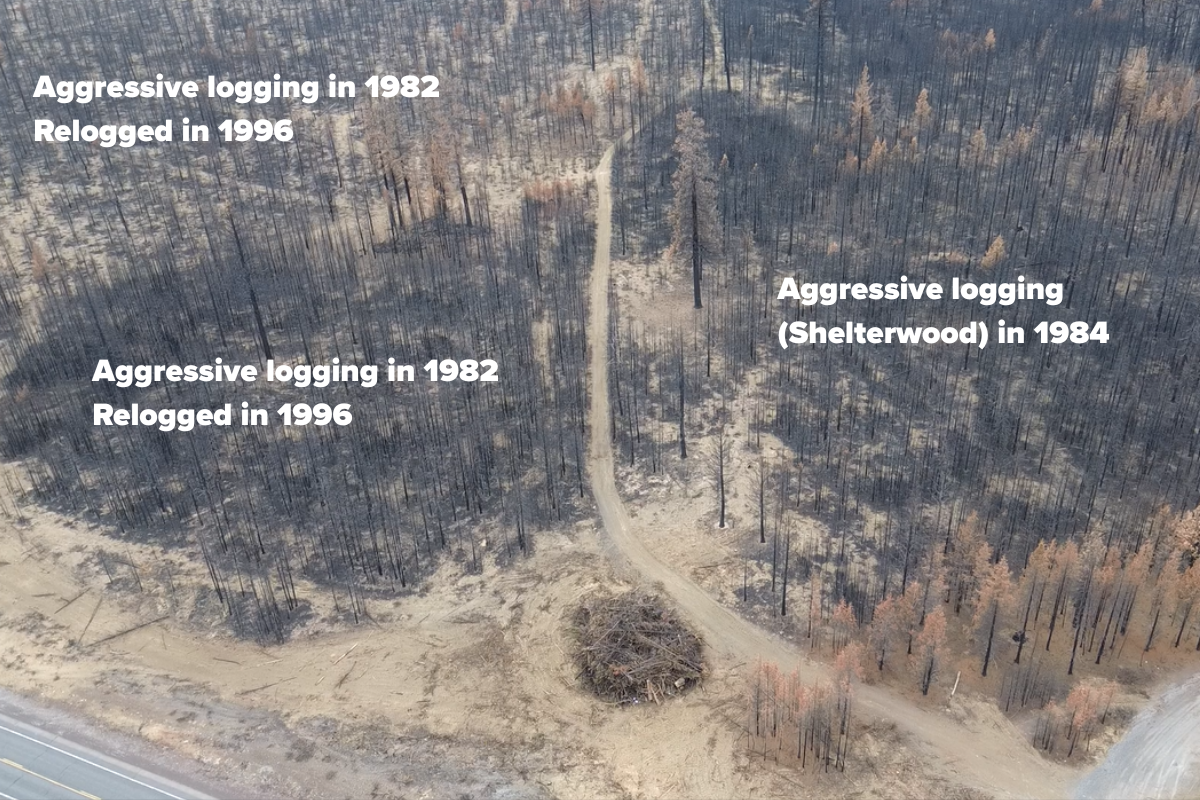
Parts of the forest burned extremely hot, killing nearly everything. The above photo shows stands that were aggressively logged in the 80s and 90s. The forest in the photo underwent a “shelterwood cut,” a term that describes a very aggressive form of logging. Imagine a clearcut, but with a few “seed trees” scattered throughout the stand that are left standing, and you have a shelterwood cut. Like a clearcut, most of the fire-resistant mature and old-growth trees are removed, and what we are seeing here is the consequences of a younger, drier, and more flammable forest.
When thinning can help
No, logging (or “active management,” “fuels reduction,” etc) does not prevent large fires and, as the Little Lava Fire demonstrates, it can (and often does) make these fires more destructive. However, there are certainly circumstances where some lighter-touch thinning makes sense and can create healthier and more resilient forests.
While the timber industry, land management agencies, and many politicians like to use logging as a one-size-fits-all blanket policy solution for all forests, the answer is not quite as clear-cut (see what I did there?) as they would like.
In reality, Oregon’s forests are incredibly diverse and have evolved differently with fire. In some places, natural low-intensity fires were common, and Indigenous peoples managed fires to promote the growth of certain foods and habitats. In other places, natural and Indigenous use of fire was rare. Decades of logging and fire suppression have left some dry forest types, like many in Central Oregon, unnaturally dense.
Restoration-based thinning and prescribed burning projects that focus on removing small trees and brush (that have grown in due to a lack of natural fires) near communities and seek to restore old-growth conditions can be beneficial in these dry forests. Efforts like the Glaze Meadow restoration project near the town of Sisters have reduced fire risks while improving habitat for fish and wildlife.
Current proposals to expand logging on public forests
Unfortunately, several concerning proposals are making their way through Congress and the Trump Administration that would increase and expand logging projects on public lands.
One of the largest is the so-called “Fix Our Forests Act.” Despite its name, this bill is merely a timber industry giveaway that would allow more logging on public lands and remove public oversight, scientific review, and environmental analysis of those logging projects. The bill passed the House of Representatives in January and is now in danger of being voted on by the Senate and sent to President Trump’s desk.
Earlier this spring, the Trump Administration issued an Executive Order and secretarial memo focused on expanding industrial logging across 60% of our National Forests–including millions of acres of roadless areas, old-growth forests, wilderness-protected lands, and critical wildlife habitat.
These proposals have nothing to do with reducing wildfire risk, and everything to do with handing control of our national public lands over to private industries that stand to profit off them.
What can you do
Contact your Senators today and tell them to oppose the Fix Our Forests Act. Reach out to your members of Congress and let them know that more logging is NOT the answer.
Advocate for the solutions that do work and do protect communities:
- Funding and investment in home hardening, defensible space, and community preparedness (learn about how you can make your home safer from fire)
- Cultural and prescribed burning in forests that have become unnaturally dense due to fire suppression
- Redirect resources used to log backcountry forests to restoration-based burning and small-diameter tree thinning projects in areas near homes and communities.
To learn more about fire and forests in Oregon, check out our blog about the Ten Things Oregonians Should Know About Forest Fires.
